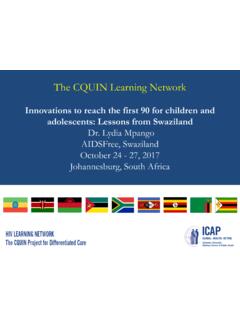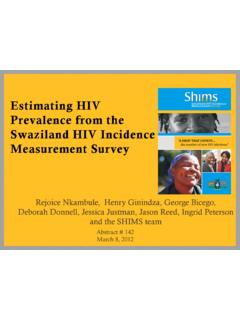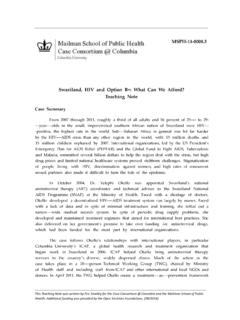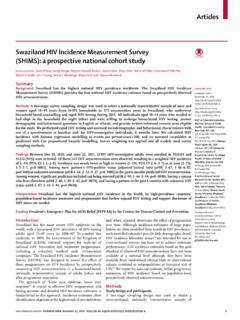Transcription of Extended National Multi-sectoral HIV and AIDS Framework ...
1 Extended National Multi-sectoral HIV and AIDS Framework (eNSF) 2014-2018 Final Evaluation Report The National Emergency Response on HIV and AIDS Acknowledgement The National Emergency Response Council for HIV and AIDS (NERCHA) is pleased to present the evaluation report of the 2014-2018 Extended National Multisectoral Strategic Framework on HIV and AIDS in swaziland . The evaluation report is presented a guide to the development of the next strategy which will lead the country to ending AIDS by 2022. NERCHA is thankful for the guidance and support from UNAIDS, the Steering committee, National Technical Task Team and the different Thematic Technical Working Groups. The steering committee comprised of: Mr. Khanya Mabuza- Executive Director, NERCHA; Dr. Vusi Magagula- Director of Health Services, Ministry of Health; Ms. Denise Johnson - PEPFAR Coordinator, United States Government; Mr. Tim Rwabuhemba- Country Director, UNAIDS; Mr.
2 Dumsani Simelane- Executive Director, SWANNEPHA and Mr. Emmanuel Ndlangamandla-Executive Director, CANGO. Member of the technical committee included: Ms. Nokwazi Mathabela- Act, Response Leader, NERCHA; Ms. Tengetile Dlamini- Research Manager, NERCHA; Ms. Nozipho Mkhatshwa- Programmes Manager NERCHA; Mr. Muhle Dlamini- Programmes Manager, SNAP; Dr. Nomthandazo Lukhele- ART Coordinator, SNAP; Mr. Tony Ao- Head of Strategic Information, CDC; Ms Mandana Askarinasab PEPFAR; Ms. Pepukai Chikukwa- UNAIDS; Ms. Gloria Bille- UNAIDS; Mr. Ian kaayo - Programmes Manager, SWANNEPHA; Ms. Lungile Mnisi Advocacy Manager, CANGO; Nqobile Tsabedze -Programmes Manager, CANGO; Dr Sithembile Dlamini-Nqheketo, WHO; Ms. Nonhlanhla Tsabedze, MTAD. NERCHA is grateful for the contributions of key informants and stakeholder groups at National , regional and community levels, consulted during this process. These include representatives of the Multi-sectoral stakeholders managing the HIV response: Government Ministries, development partners, People Living with HIV, implementing partners, Civil Society Organizations and local communities who provided their valuable insights on the HIV and AIDS response in the country.
3 This report has to the extent possible synthesized and presented the input of these stakeholders to inform the future of the HIV response in swaziland . Contents Executive Summary .. i Introduction .. 1 Background .. 1 Evaluation rationale .. 2 Evaluation approach, methods and limitations .. 2 Relevance .. 4 Impact .. 6 Umgubudla fast track programme (HIV Investment Case) .. 9 Effectiveness/performance of the eNSF .. 11 Prevention of new infections .. 11 HIV Testing and Services .. 11 Social and behaviour change .. 15 Condom promotion and distribution .. 18 Priorities .. 21 Prevention of Mother to Child 21 Male circumcision .. 24 Customized interventions for key populations and vulnerable groups .. 27 Treatment, care and support .. 31 Pre-Antiretroviral (Pre-ART) services .. 31 Antiretroviral therapy for PLHIV (ART) .. 33 TB/HIV co-infections .. 38 Care and support for Orphaned and Vulnerable Children.
4 40 Family strengthening .. 40 Gender based violence .. 45 Management and coordination of the HIV and AIDS response .. 49 National Emergency Response Council on HIV and AIDS (NERCHA) .. 50 Sector coordination .. 51 Regional Coordination of the HIV response .. 56 Mainstreaming in development sectors .. 59 Internal mainstreaming .. 59 External mainstreaming .. 63 Inclusiveness, human rights and gender .. 66 Funding of the HIV response .. 67 Strategic Information and Knowledge Management .. 72 Recommendations .. 75 List of tables Page Table 1: eNSF core programmes and response management 1 Table 2: eNSF impact indicators and targets compared to current status 7 Table 3: Progress towards Umgubudla targets 10 Table 4: HTS for pregnant women, 2012-2015 23 Table 5: Uptake of HTS by male circumcision clients 27 Table 6: ART retention rates for children and adults 34 Table 7: Number of the elderly receiving Old Age Grants quarterly 41 Table 8: Number of OVCs and fee payment 2009-2016 42 Table 9: Expenditure rate by Ministry of Health HIV Programme 71 List of figures Page Figure 1: Comparison of HIV prevalence SHIMS 2011 and 2016-17 6 Figure 2: HIV incidence by age and sex (SHIMS 2, 2016-17) 7 Figure 3: estimated AIDS related deaths by gender, 2013-2020 8 Figure 4: Estimated AIDS deaths with and without ADR, 2013-2020 8 Figure 5: Life expectancy 1990-2015 8 Figure 6.
5 Life expectancy in southern Africa countries, 2015 8 Figure 7: Proportion of people tested for HIV and received their results by sex, 2015 11 Figure 8: Male condom distribution, 2016 19 Figure 9: Female condom distribution, 2016 19 Figure 10: Number of STIs and percentage of pregnancies among adolescents 20 Figure 11: PMTCT outcomes, 2016 21 Figure 12: Sero-conversion of pregnant women during ANC 23 Figure 13: % circumcised against total male population 2013-2016 25 Figure 14: Male circumcision annual totals 2009-2016 25 Figure 15: Male circumcision by age group totals 2009-2016 25 Figure 16: 90-90-90 achievements by sex 34 Figure 17: 90-90-90 achievements by age 34 Figure 18: Trend of patients newly initiated on ART by facility level, 2009-15 36 Figure 19: TB/HIV programme outputs, 2016 38 Figure 20: TB/HIV programme outputs, 2016 38 Figure 21: Estimated number of orphans, 2013 2020 40 Figure 22: AIDS orphans as a proportion of total orphans 40 Figure 23: Net enrolment rates primary, 1999-2012 41 Figure 24: Survival rates, primary level, 2012 41 Figure 25: Trends in net enrolment at primary and secondary, 2009-13 43 Figure 26: Annual funding for HIV, 2014-2017 67 Figure 27: Trend in HIV funding 68 Figure 28: Trend in HIV funding 68 Figure 29: Share of total funding by funding source 68 Figure 30: Share of total external funding by major funding sources 69 Figure 31: Major items for allocation of government funding to HIV 69 Figure 32: Global Fund HIV grant absorption (NERCHA grant) 70 Figure 33.
6 Global Fund absorption by programmatic area (CANGO) 70 Abbreviations and Acronyms AGYM Adolescent Girls and Young People AMICAALL Alliance of Mayors Initiative for Community Action on AIDS at the Local Level ANC Antenatal Care CANGO Coordinating Assembly for Non-Governmental Organizations CHEPRA Comprehensive HIV Epidemiological and Response Analysis CHIMSHACC Chiefdom Multi-sectoral HIV and AIDS Coordination Committee CBO Community Based Organisation CMS Central Medical Store CSO Civil Society Organisation EID Early Infant Diagnosis EIMC Early Infant Male Circumcision eNSF Extended Mutlisectoral HIV and AIDS Strategic Framework ECCD Early Child Care and Development FLAS Family Life Association of swaziland FBO Faith Based Organization FP Family Planning FSW Female Sex Worker GBV Gender Based Violence HTS HIV Testing Services HMIS Health Management Information System KP Key Population M&E Monitoring and Evaluation MICS swaziland Multiple Indicator Survey MSF M decins Sans
7 Fronti res MSM Men Who Have Sex With Men NERCHA National Emergency Response Council for HIV and AIDS NGO Non-Government Organisation NTCP National TB Control Programme PLHIV People Living With HIV PMTCT Prevention of Mother to Child Transmission PNC Post Natal Care PITC Provider Initiated Testing and Counselling PSHACC Public Sector HIV and AIDS Coordinating Committee OVC Orphans and Vulnerable Children REMSHACC Regional Multi-sectoral HIV and AIDS Coordinating Committee RHMT Regional Health Management Team SBC Social and Behaviour Change SHAPMOS swaziland HIV and AIDS Programme Monitoring System SHACO swaziland HIV & AIDS Consortium SNAP swaziland National AIDS Programme SWANNEPHA swaziland Network of People Living with HIV and AIDS SHIMS swaziland HIV incidence measurement Survey SRH Sexual and Reproductive Health SWABCHA, swaziland Business Coalition on HIV and AIDS SUSAH swaziland Uniformed Services Association STI Sexually Transmitted Infection TIMSHACC Tinkhundla Multi-sectoral HIV and AIDS Coordinating Committee TWG Technical Working Group VMMC Voluntary Medical Male Circumcision I Executive Summary Introduction The evaluation of the Extended Multisectoral HIV and AIDS National Strategic Framework (eNSF) 2014-2018 was commissioned to assess progress in meeting the HIV and AIDS response targets as well as the country s progress towards achievement of the Umgubudla targets.
8 The findings of the evaluation will inform the strategic direction for a new strategy 2018-2022. The specific areas covered by the evaluation are as follows: Performance of the HIV and AIDS response Contribution to National development efforts, in particular mainstreaming HIV in the development sector and Ending AIDS by 2022 Inclusiveness of the HIV response Resources for the HIV response Strength of the Three Ones Principles including coordination and implementation arrangements The evaluation was conducted through a review of key documents providing secondary data, key informant interviews, consultations with various stakeholder groups at the National level. At the regional level interviews were undertaken with regional level leaders, consultations were held with REMSHACCs, TIMSHACCs and CHIMSHACCs while focus group discussions were conducted with men, youth, women and PLHIV. These data sources informed the findings and recommendations in this report.
9 Key findings Relevance: eNSF is responsive to National development priorities, international goals and normative guidance. It also addresses the relevant drivers of the epidemic and targets the right populations. The Framework was widely disseminated but some stakeholders found it too technical to understand and identify with. Impact of the eNSF: New HIV infections are declining and the 2018 target of has been met. The incidence rate declined from in 2011 to in 2017. This means new infections have decreased almost by half between 2011 and 2017. However, new infection are higher among adolescents and young people compared to other groups. AIDS deaths are declined by 24% between 2013 and 2016. A higher number of AIDS deaths occur among men partly because they present late for treatment. Life expectancy has marginally improved having increased from years for men in 2010 to years in 2015 while the increase among women was from to years in the same period.
10 However, swaziland is ranked last among the neighbouring southern Africa countries. The efficiency of the governance of the response is sub-optimal due to weak accountability, inadequate coordination and resource limitations. 27% of the service coverage targets achieved by 2015 (mid-term) and 49% of the output/coverage indicators had no data. Umgubudla fast track programme: The country on track to achieve the ART, PMTCT and TB/HIV co-infection targets. Progress has been made towards the achievement of all the 90-90-90 targets. of PLHIV 15 years and above know their HIV status. Of these, are on ART treatment and out of this proportion, are virally suppressed. Male circumcision programme has achieved low results and the target of 70% is not likely to be met unless huge investments are made and continuous innovation of approaches is maintained. II HIV prevention a) HIV testing services: HIV Tests have been scaled up over time and the service is widely available.









